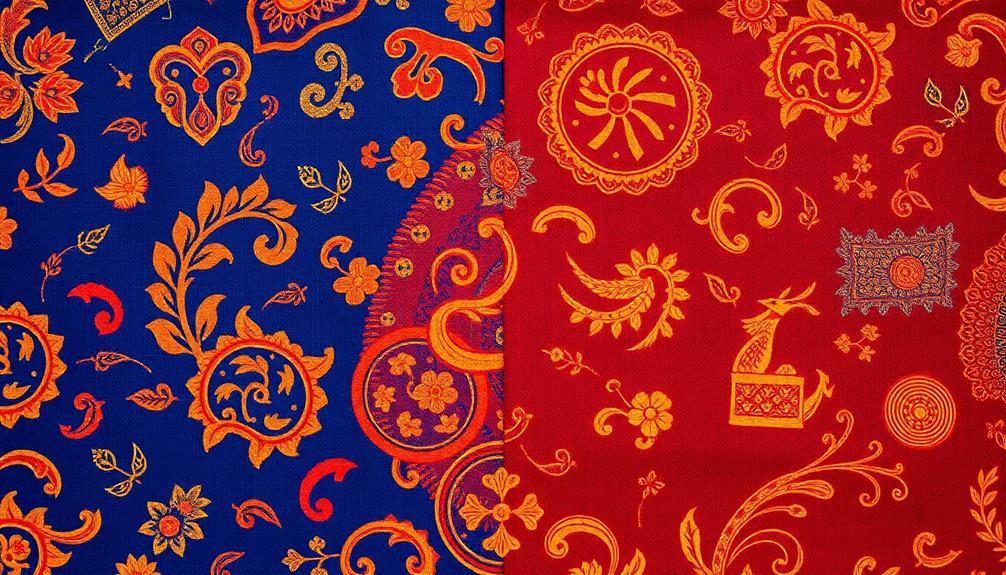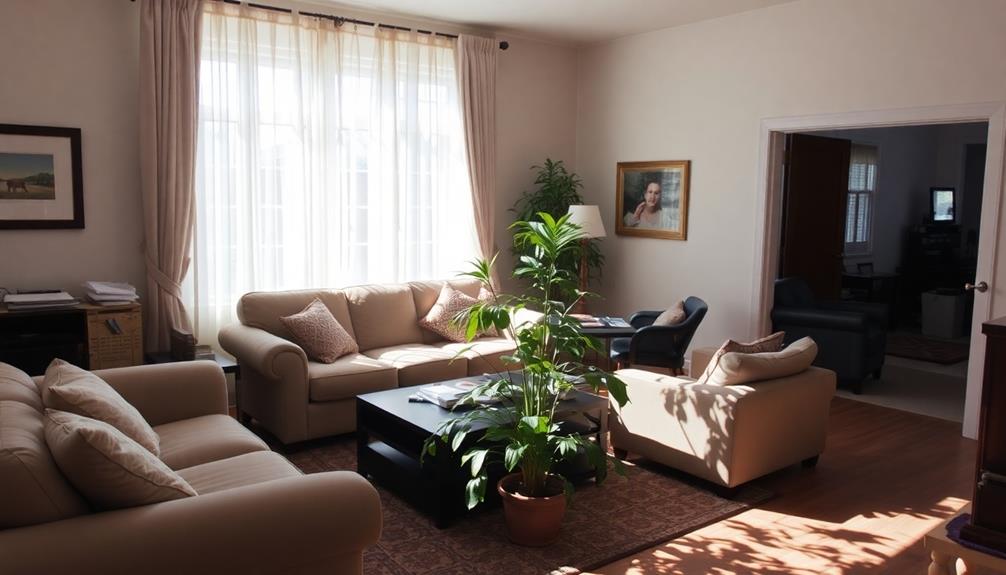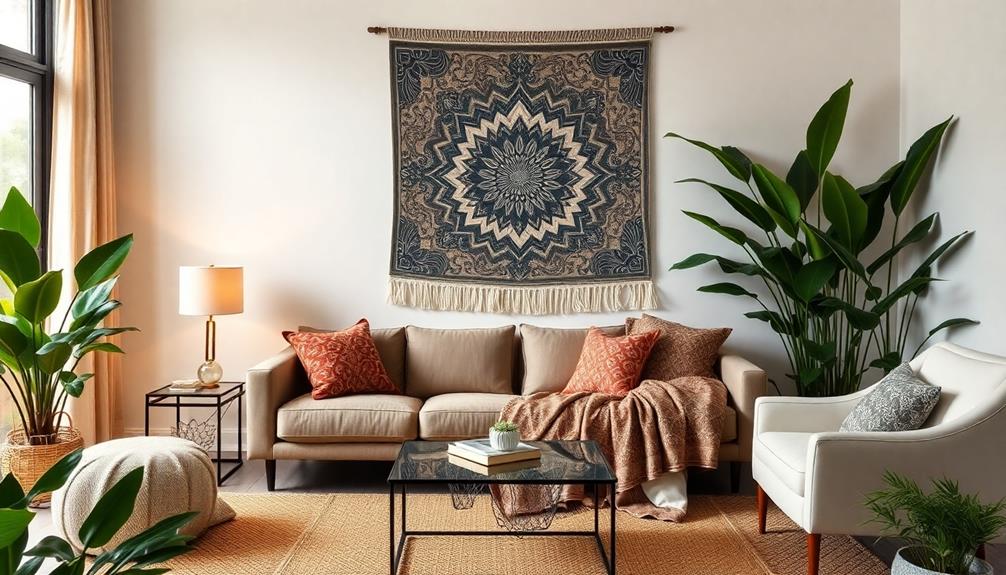You won't believe the rich symbolism behind stunning batik patterns! Originating in Indonesia, each design tells a story tied to cultural identity and local traditions. For instance, the "parang" pattern represents strength and royal power, while the "kawung" signifies purity and balance. Batik reflects nature, spirituality, and folklore, deeply influencing the wearer's fate. Javanese batik, with intricate motifs, contrasts with the bold colors of Balinese styles, showcasing diversity. Plus, modern fashion embraces these timeless patterns, connecting heritage with contemporary aesthetics. Discover more about the significance and artistry of these breathtaking designs and how they resonate through history.
Key Takeaways
- Batik patterns like "parang" symbolize strength and power, often associated with Javanese royalty and social status.
- The "kawung" design represents purity and harmony, reflecting balance found in nature and spirituality.
- "Mega Mendung" features cloud motifs that signify hope and prosperity, deeply rooted in Indonesian folklore.
- Each batik pattern conveys cultural identity, with meanings intertwined with local customs and traditions across Indonesia.
- Patterns not only showcase artistry but also influence the wearer's fate, linking personal identity with cultural heritage.
Historical Roots of Batik

Batik has a fascinating history that traces back to Indonesia, particularly on the island of Java, where its roots extend as far back as the 4th century. This traditional art form is more than just fabric; it's an essential part of the region's cultural heritage.
The term "batik" comes from the Javanese word "ambatik," which means "writing with a dot." This reflects the intricate designs created using the wax-resist dyeing technique, showcasing the skill and creativity of artisans. Additionally, batik patterns often echo the vibrant artistry found in Indonesian decor masks, further enhancing the cultural significance of these handcrafted items.
In 2009, batik was recognized as a UNESCO Intangible Cultural Heritage, emphasizing its significance in preserving cultural identity and artistry. Each piece of batik tells a story, serving as a symbol of social status and cultural identity.
Specific patterns and colors carry deep meaning, reflecting the wearer's beliefs and societal roles. Additionally, various regions in Indonesia boast unique batik styles and motifs, each showcasing local customs and traditions.
This rich diversity not only highlights the artistry of batik but also connects you to the history and values of the Indonesian people. Embracing batik means embracing a vibrant cultural legacy that continues to thrive today.
Symbolic Meanings of Patterns
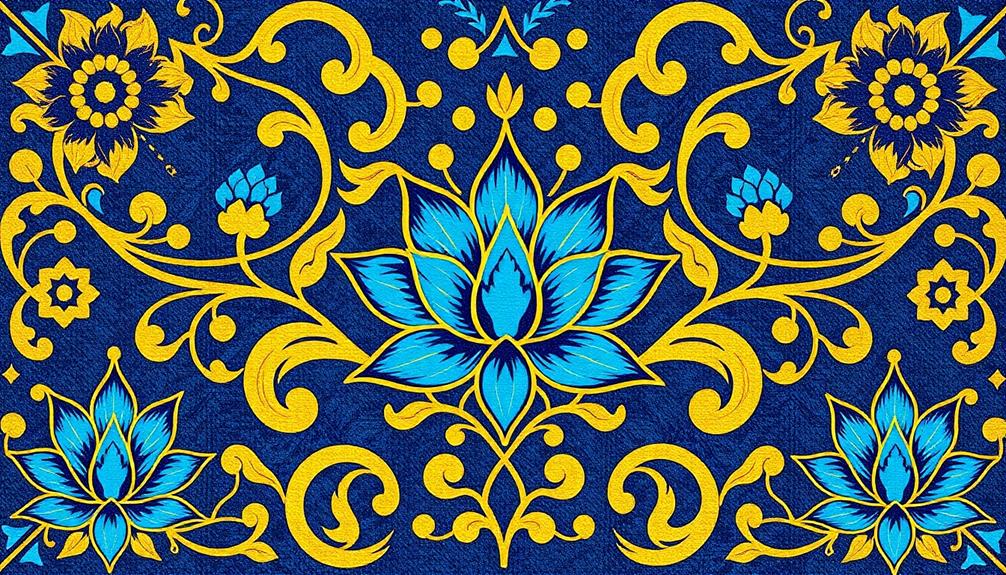
Many batik patterns hold deep symbolic meanings that reflect the culture and beliefs of the Indonesian people. For instance, the "Parang" pattern symbolizes strength and power, historically linked to Javanese royalty. This intricate design is often featured in various decor items, including Indonesian decorative pillows, allowing you to embrace resilience and the rich cultural significance it embodies.
Another notable design is "Kawung," which resembles the sugar palm fruit. It signifies purity and harmony, representing a balance in nature and life. Its vibrant colors and intricate patterns create a visual feast while conveying deep meanings.
Then there's the "Mega Mendung," featuring cloud motifs that represent hope and prosperity. This design embodies a sense of calmness, encouraging positivity in life. Each batik pattern tells a unique story, often rooted in nature, spirituality, and local folklore, influencing your fate as the wearer.
These batik patterns serve not just as decorative elements but also as cultural symbols that reflect social status and identity within Indonesian heritage.
Regional Styles and Characteristics

Understanding the symbolism behind batik patterns sets the stage for exploring the diverse regional styles that showcase unique characteristics and artistry.
Javanese batik is renowned for its intricate designs, with motifs like "parang," symbolizing strength, and "kawung," representing purity and harmony. This style emphasizes detailed patterns that reflect the cultural heritage of Java, much like the vibrant artistry found in traditional Indonesian decor masks.
In contrast, Balinese batik stands out with its bold colors and freeform designs, often inspired by nature. This vibrant approach captures the island's spirit and distinct cultural identity.
Meanwhile, Trusmi batik, originating from Cirebon in West Java, employs the canting tool to create intricate detailing featuring unique natural motifs, emphasizing the area's artisanal skill.
Lasem batik beautifully showcases a blend of Javanese and Chinese influences, using vibrant colors like deep reds and blues that symbolize life, creating a rich cultural narrative.
Each region's batik fabrics reflect local customs, traditions, and histories, with Solo batik often used in ceremonial contexts to convey specific social messages through family patterns.
Batik's Role in Modern Fashion
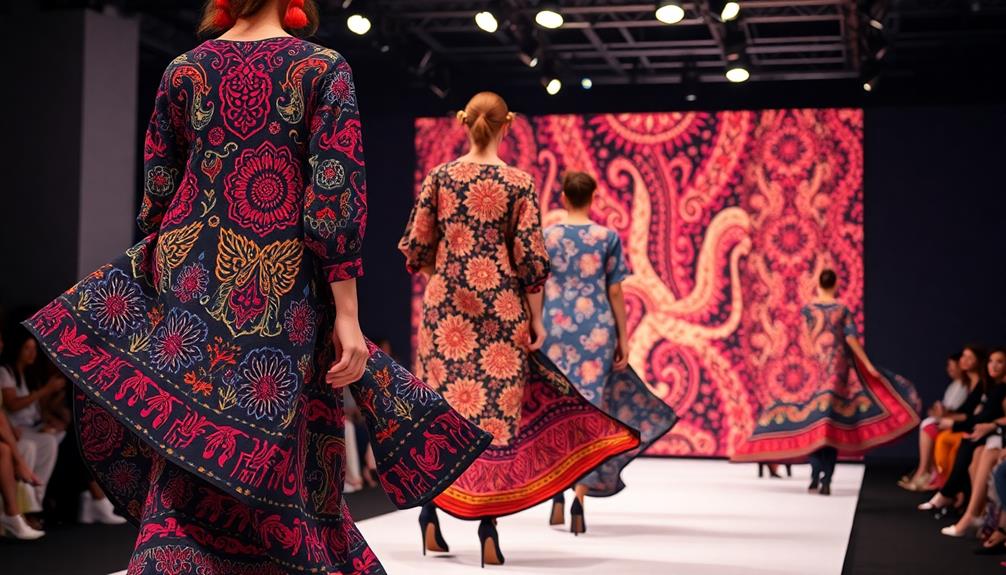
In recent years, batik has emerged as a vibrant trend in modern fashion, enchanting designers and consumers alike. This ancient technique has gained immense popularity across global fashion markets, with many designers integrating traditional batik patterns into contemporary clothing lines.
The versatility of batik allows it to shine in a wide range of fashion items, from casual wear to haute couture, catering to diverse consumer preferences. Additionally, the intricate craftsmanship of batik aligns beautifully with the principles of traditional Indonesian style home decor, emphasizing harmony with nature and cultural richness.
Collaborations between traditional batik artisans and modern fashion designers have birthed innovative designs that honor cultural heritage while appealing to current aesthetics. These partnerships not only elevate the fashion scene but also promote sustainable fashion practices by emphasizing local craftsmanship. Supporting these artisans helps preserve traditional techniques that have been passed down through generations.
Fashion shows and cultural festivals celebrating batik have further contributed to its resurgence, raising awareness of its significance in contemporary fashion. You can see how batik's rich history and artistry resonate with today's consumers, inspiring new generations of designers to explore this unique textile.
As you embrace batik in your wardrobe, you're not just making a style statement; you're also supporting a movement that values tradition and sustainability.
Cultural Significance and Preservation

Batik weaves a rich tapestry of cultural significance, serving as a vibrant expression of Indonesia's heritage and history. Recognized as a UNESCO Intangible Cultural Heritage, batik reflects Indonesia's narratives through its intricate patterns and designs. Each piece carries unique symbolism, tied to local traditions, beliefs, and social statuses, making this craft essential to various ceremonies and rituals.
Additionally, the craftsmanship involved in creating batik shares similarities with other traditional Indonesian arts, such as the importance of Indonesian decor masks, showcasing the depth of cultural storytelling present in these crafts. The traditional craftsmanship involved in creating batik is labor-intensive and requires years of training. This dedication emphasizes the importance of preservation, as it guarantees that this art form doesn't fade away.
Cultural festivals celebrating batik play a significant role in raising awareness and appreciation, featuring exhibitions and workshops that connect local artisans with international designers.
Moreover, the resurgence of batik in modern fashion revitalizes interest in these traditional techniques and supports local artisans. By embracing sustainable practices, you help secure the continuity of this cultural heritage for future generations.
In appreciating batik, you're not just admiring beautiful patterns; you're participating in the preservation of a rich cultural legacy that embodies the spirit of Indonesia.
Frequently Asked Questions
What Does Batik Symbolize?
Batik symbolizes various cultural elements, reflecting nature, spirituality, and folklore. Each pattern conveys specific meanings, like strength, purity, and hope, revealing the rich heritage and identity of the communities that create these beautiful textiles.
What Is the Meaning of Batik Pattern Design?
Imagine vibrant colors swirling like a dance, each batik pattern revealing stories from nature and history. You'll discover meanings of strength, purity, and hope, woven intricately into the fabric, echoing the rich cultural heritage of Indonesia.
What Is the Meaning of Batik Flower Pattern?
Batik flower patterns symbolize beauty, growth, and fertility. By incorporating designs like the lotus and hibiscus, you connect with cultural meanings that resonate deeply with nature and spirituality, enriching your understanding of this art form.
What's so Special About Batik?
They say beauty is in the details, and batik proves it. Each piece tells a story, showcasing intricate designs that reflect cultural heritage. You'll appreciate the craftsmanship, unique colors, and deep meanings behind every pattern.
Conclusion
In exploring the stunning world of batik, you've uncovered rich histories and deep symbolism woven into each pattern. For instance, imagine wearing a batik shirt that tells the story of your heritage, connecting you to generations past. As batik continues to thrive in modern fashion, it is crucial to appreciate and preserve its cultural significance. So next time you see a batik piece, remember—it's not just fabric; it's a narrative waiting to be discovered.
